Ramoji Film City
Ramoji Film City is an integrated film studio facility located in Abdullahpurmet, Hyderabad, India. Spread over 1,666 acres (674 ha),[1][2] it is the largest film studio complex in the world[3][4][5] and as such has been certified by the Guinness World Records.[6] It was established by Telugu media tycoon Ramoji Rao in 1996.[7][8][1] The Guardian described Ramoji Film City as "city within a city."[3]

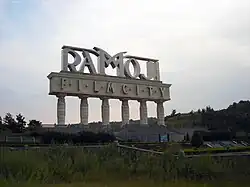 Entrance to Ramoji Film City | |
| Type | Privately held company |
|---|---|
| Industry | Motion pictures |
| Founded | 1996 |
| Founder | Ramoji Rao |
| Headquarters | , |
Key people | Ramoji Rao |
| Parent | Ramoji Group |
| Website | ramojifilmcity |
It is also a thematic holiday destination and a popular tourism and recreation centre, containing natural and artificial attractions including an amusement park. Around 1.5 million tourists visit the place every year.[9][5][7]
History
The film city is the brainchild of media tycoon and film producer Ramoji Rao, who wanted to build a studio similar to the ones in Hollywood.[1] On procuring the land, he signed art director Nitish Roy to design the complex. According to an executive, the builders kept the land, which at that time consisted of jungles and mountainous terrain, intact, without removing one tree or mountain. It was built in Hyderabad in 1996 in the outskirts of the city in Abdullahpurmet.[10] Maa Naannaku Pelli (1997) was the first film shot in the studio.[11]
Studio facilities
The studio has sets such as forests, gardens, hotels, a railway station, an airport, apartment blocks, mansions and workshops etc.[7] There is a central kitchen for the various film units shooting at any given point of time. The film city also has 6 hotels inside it, 47 sound stages and permanent sets ranging from railway stations to temples.[6] The film city has about 1,200 employees, and 8,000 agents.[7] The film city also handles about 400-500 films per annum in various Indian languages. On any given day, it has the capacity to facilitate 15 shoots.[7] Vintage buses and AC Coach are available to travel inside Ramoji Film City.
Tourism
People can visit the film sets, theme parks, amusement rides, etc.[1] The film city also has the set used for the films Baahubali: The Beginning (2015) and Baahubali 2: The Conclusion (2017); all the statues and props used in the films can be seen here. Around 1.5 million tourists visit the place every year.[9][5][7]
Gallery
.JPG.webp) Ramoji Film City
Ramoji Film City.jpg.webp) A railway Station set inside Ramoji Film City, which was used in the movie, Chennai Express
A railway Station set inside Ramoji Film City, which was used in the movie, Chennai Express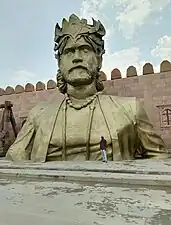 A statue of the character "Bhallaladeva" from the Baahubali films in Ramoji Film City
A statue of the character "Bhallaladeva" from the Baahubali films in Ramoji Film City Burasura at Fundustan fun area at Ramoji Film City 3499
Burasura at Fundustan fun area at Ramoji Film City 3499 Photo from Eureka fun place at Ramoji Film city, Hyderabad
Photo from Eureka fun place at Ramoji Film city, Hyderabad.JPG.webp) Ramoji Film City, Hyderabad - views from Ramoji Film City
Ramoji Film City, Hyderabad - views from Ramoji Film City Dilse restaurant at Ramoji Film Ciy hyderabad
Dilse restaurant at Ramoji Film Ciy hyderabad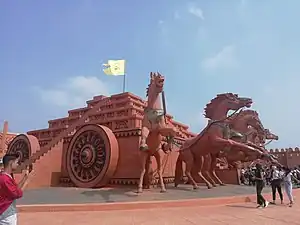 Bahubali film set in Ramoji Film City, Hyderabad, India
Bahubali film set in Ramoji Film City, Hyderabad, India Film sets in Ramoji Film City, Hyderabad, India
Film sets in Ramoji Film City, Hyderabad, India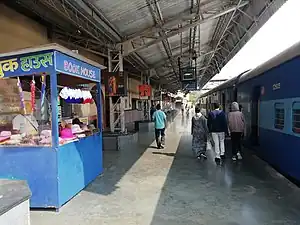 Railway station platform set in Ramoji Film City
Railway station platform set in Ramoji Film City Film sets in Ramoji Film City, Hyderabad, India
Film sets in Ramoji Film City, Hyderabad, India A view from Main Fun area of Ramoji Film City hyderabad
A view from Main Fun area of Ramoji Film City hyderabad Mock of Rajastan Palace
Mock of Rajastan Palace Historical bhagavatam set in ramoji film city
Historical bhagavatam set in ramoji film city The Vrindavan garden setting in Ramoji Film city Hyderabad
The Vrindavan garden setting in Ramoji Film city Hyderabad.jpg.webp) Ramoji Film City - Mughal Garden - Brindavan
Ramoji Film City - Mughal Garden - Brindavan.JPG.webp) Ramoji Film City, Hyderabad - views from Ramoji Film City
Ramoji Film City, Hyderabad - views from Ramoji Film City.JPG.webp) Ramoji Film City, Hyderabad - views from Ramoji Film City
Ramoji Film City, Hyderabad - views from Ramoji Film City Mughal gardens at Ramoji Film City
Mughal gardens at Ramoji Film City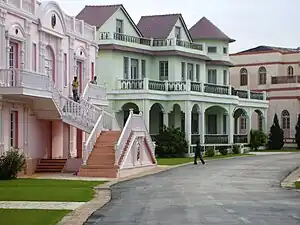 The creation of England in the picturesque city of Ramoji Film City
The creation of England in the picturesque city of Ramoji Film City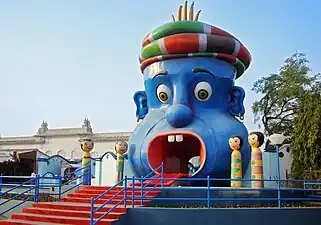 Ramoji Film City, Hyderabad, India
Ramoji Film City, Hyderabad, India.JPG.webp) Ramoji Film City, Hyderabad - views from Ramoji Film City
Ramoji Film City, Hyderabad - views from Ramoji Film City
See also
- Telugu Cinema
- Wonderla Amusement Park, Raviryal, Kongar Khurd, Hyderabad
- Film City, Mumbai
- Film and Television Institute of India
- State Institute of Film and Television
References
- Nathan, Archana (6 February 2018). "At Ramoji Film City in Hyderabad, everything is about show business (and not just for filmmakers)". Scroll. Retrieved 1 May 2018.
- "Ramoji Film City sets record". Business Line. 3 August 2005. Archived from the original on 13 December 2012. Retrieved 10 January 2012.
- Reith-Banks, Tash (29 January 2019). "Tollywood confidential: inside the world's biggest film city". The Guardian. ISSN 0261-3077. Retrieved 25 June 2020.
- "Survey of world's biggest film facilities". The Hollywood Reporter. 30 August 2007. Retrieved 13 August 2022.
- Iyer, Pico (7 February 2012). "In India, the World's Largest Movie Studio—and Its Colorful Films". Vanity Fair. Retrieved 13 August 2022.
- "Largest film studio". Guinness World Records. Retrieved 2 January 2021.
- Reddem, Appaji (4 March 2022). "Is Telugu cinema set for a change of scene Hyderabad to Visakhapatnam?". The Hindu. ISSN 0971-751X. Retrieved 12 September 2022.
- "About us - Ramoji Film City". Ramoji Film City. Retrieved 3 September 2017.
- "Ramoji Film City may lose land to ORR - Hyderabad - City". The Times of India. 6 July 2006. Archived from the original on 11 August 2011. Retrieved 6 September 2010.
- Reddem, Appaji (4 March 2022). "Is Telugu cinema set for a change of scene Hyderabad to Visakhapatnam?". The Hindu. ISSN 0971-751X. Retrieved 12 September 2022.
Ramoji Film City, which was built in Hyderabad in 1996 ....
- Dasagrandhi, Madhuri (8 July 2018). "Where the magic gets unfolded". Telangana Today. Archived from the original on 2 November 2019. Retrieved 3 December 2022.